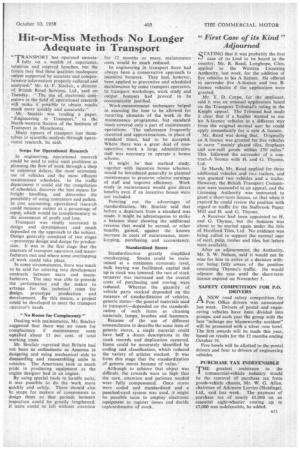Hit-or-Miss Methods No Longer Adequate in Transport
Page 45

If you've noticed an error in this article please click here to report it so we can fix it.
" TR AN SPO RT has operated success ' fully on . a wealth of experience, intuition and inspired hunches, but the future ma Y fitid these qualities inadequate unless supported by accurate and comprehensive information properly collated and analysed," Mr: G. F. Sinclair, a director of British Road; Services, Ltd.,. said on,
• Tuesday. " The use of, electronic corn-... putors in the field'or operational research will make' it possible to obtain results much more quickly and accurately."
Mr.Sinclair was -reading a paper, "Engineering in Transport," to the
• North-western Section of the Institute of Transport in Manchester.
Many aspects of transport .lent themselves to seientific analysis through operational research, he said.
Scope for Operational Research
In engineering, operational research could be used to solve such problems as planning the flow of work through a shop to minimize delays, the most economic use of vehicles and the most efficient maintenance schedules. In the traffic department it could aid the compilation of schedules, discover the best means for freight handling, and determine the possibility of using containers and pallets. In cost accounting, operational research could measure output as a percentage of input, which would be complementary to the issessment of profit and loss.
Transport was vitally interested in design and development and • much depended on the approach to the subject. Design generally consisted of two stages —prototype design and design for production. It was in the first stage that the interests of transport operators and manufacturers met and where some overlapping of work could take place.
In some circumstances, there was much to be said for entering into development contracts between users and manufacturers. The user was able to provide the performance and the maker to arrange for the technical team for design, prototype production and development. By this means, a project could be developed to meet the transport operator's needs.
"No Room for Complacent'y " Dealing with maintenance, Mr. Sinclair suggested that there was no room for complacency if maintenance costs equalled about 1.5 per cent. of total working costs.
Mr. Sinclair regretted that Britain had not been as enthusiastic as America in designing and using mechanical aids to dismantling and reassembling units in vehicles. The Americans took as much pride in producing equipment as the engine designer had in an engine.
By using special tools to handle units, it was possible to do the work more quickly and safely. There should also be scope for makers of components to design them so that periods between inspection could be greatly lengthened. If units could be left without attention for 12 months or more, maintenance costs would be much reduced.
In engineering in transport there had always been a conservative approach to incentive 'bonuses. They had, however, been applied to preventive and scheduled Maintenance by some transport operators. In transport workshops, work study and Output bonuses had proved to be economically justified.
Work-measurement techniques helped in assessing the time to be allowed for recurring elements of the work in the maintenance programme, but standard times covered only a part of maintenance operations. The unforeseen frequently occurred and approximations, in place of standard times, had to be accepted. Where there was a great deal of nonrepetitive work a large administrative staff was necessary to operate a bonus scheme.
It. might be that method study, together with incentive bonus schemes. would be introduced generally in planned maintenance to preserve relative earnings of staff and improve efficiency. Work study in maintenance would give direct benefits even if an incentive bonus were not included.
• Pointing out the advantages of standardization, Mr. Sinclair said that before a departure from a standard was made, it might be advantageous to strike a balance sheet showing the additional revenue that would be earned, or other benefits gained, against the known increase in costs of maintenance, storekeeping, purchasing and accountancy.
Standardized Stores Standardization greatly simplified storekeeping. Stocks could be maintained at a minimum economic level, bulk buying was facilitated, capital tied up in stock was lowered, the rate of stock turnover was increased and the overall costs of purchasing and storing were reduced. Whereas the quantity of vehicle parts stocked depended on the measure of standardization of vehicles, generic stores—the general materials used in transport—depended on the standardization of such items as cleaning materials, lamps, brushes and hammers.
Because of the use of different nomenclature to describe the same item of generic stores, a single material could have half a dozen descriptions in the stock records and duplication occurred. Items could be accurately identified by coding and classification, which reduced the variety of articles stocked. It was from this stage that the standardization of generic stores became of value.'
Although to achieve that object was difficult, the rewards were so high that the care, attention and patience needed were fully compensated. Once stores were coded and standardized and a punched-card system was used, it might be possible soon to employ electronic equipment to register issues and decide replenishments of stock.




































































































